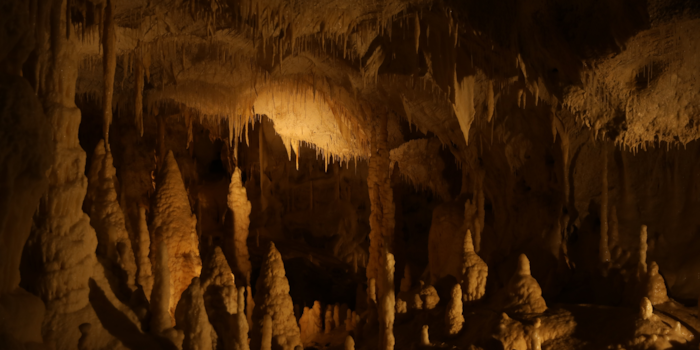
The surprisingly simple maths of stalactite caves
Stalagmites in stalactite caves often have bizarre shapes. However, they actually follow a simple rule. Whether they are pointed, round or flat is determined by a single number.
Stalactite caves are among the most spectacular natural wonders. When you enter them, you often find yourself in a whole forest of bizarre stone pillars, the most striking of which in many countries have imaginative names such as «birthday cake» or «devil's finger». In reality, however, there are only three basic shapes behind the apparent variety of forms, which in turn can be traced back to a single number. This is the conclusion reached by a working group led by Piotr Szymczak from the University of Warsaw using a mathematical model of growing stalagmites. As the team reports in the scientific journal «PNAS», in an ideal cave either narrow columns, tapering cones or broad pedestals with a flat surface grow. Which shape is formed depends on the Damköhler number, which is calculated from physical parameters. The model can also be used to obtain more precise climate data from stalagmites, according to the experts.
The fascinating rock formations of the stalactite caves are the result of a relatively simple process. Water that seeps into the earth absorbs carbon dioxide from soil organisms, making it more acidic. Deeper in the rock, it dissolves calcium carbonate. When the water finally reaches the cave, the carbon dioxide outgasses again and the calcium carbonate can no longer remain dissolved. This is how impressive structures reminiscent of waterfalls or cathedrals, stalactites and stalagmites, are formed from the calcium carbonate. As Szymczak's team determined on the basis of detailed calculations, the growth form of the stalagmites depends on just three factors: the speed at which the calcium carbonate from the water is deposited on surfaces, the area of the stalagmite base and the rate at which the water drips from the ceiling. If you divide the first two variables by the third, you get the Damköhler number.
If the conditions in the cave remain constant, Damköhler numbers below one result in tapered stalagmites, while Damköhler numbers above one result in flat-topped stalagmites and Damköhler numbers close to one result in columns with roughly semi-circular tops. However, the experts point out that the model has some weaknesses. For example, it only works if the stalagmites are wetted by a continuous film of water, which is not always the case. In addition, the conditions in caves change over time. However, this in turn makes the result more relevant. Because the rock formations in dripstone caves that have grown over thousands of years are also used as a climate archive by analysing their «growth rings» for changes in isotope composition, for example. With the help of the Damköhler number, which depends on the water flow and carbon dioxide concentration, it may also be possible to draw further conclusions about the past climate from the shape.
Spectrum of science
We are partners of Spektrum der Wissenschaft and would like to make well-founded information more accessible to you. Follow Spektrum der Wissenschaft if you like the articles.
Original article on Spektrum.de
Experts from science and research report on the latest findings in their fields – competent, authentic and comprehensible.
From the latest iPhone to the return of 80s fashion. The editorial team will help you make sense of it all.
Show all